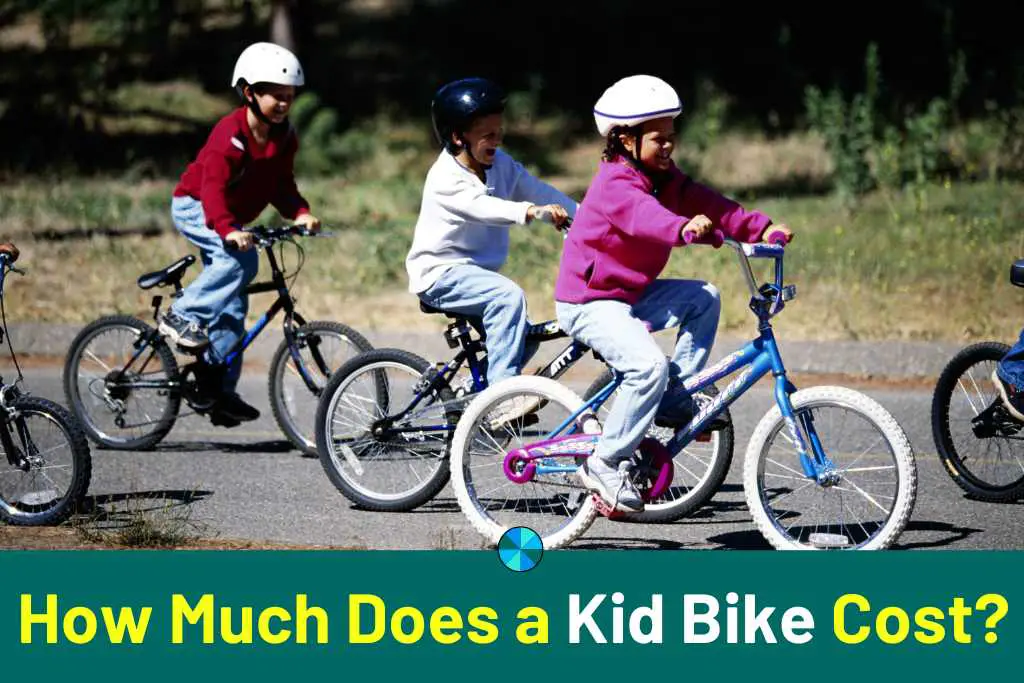Learning to ride a bike and enjoying the outdoors riding around is something that many children adore, but it’s not always affordable. So much should you expect to pay for a kid’s bike?
The cost of a kid’s bike can vary greatly depending on the size and quality, but you can expect to pay around $350. However, some options are cheaper in the $100 to $280 range that may be more affordable for some families.
Let’s learn the best bikes you can choose from, what they cost, and some features you should look for in a good quality kid’s bike so you pick the best one for your price range.
🚴🚴 CLICK HERE TO CHECK THE BEST KID’S BIKE ON AMAZON 🚴🚴
How Much Does a Kid Bike Cost?
Numerous children’s bike manufacturers frequently appear in rankings of the best children’s bikes.
These businesses were all founded with the idea of creating a beautiful kids’ bike to enhance a child’s riding experience, and they are all built with meticulous attention to detail.
Read also >> Bike Size Chart: 7 Easy Methods How To Choose Right Bicycle
Read also >> Can You Put 26 Inch Wheels On A 24 Inch Bike? (Answered!)
Best Budget Kid’s Bikes
| Bike Type | Price |
|---|---|
| Btwin Kids Bikes | $109 |
| Forth Bikes | $235 |
| Polygon Bikes | $289 |
| Guardian Ethos | $279 |
Best Everyday Kid’s Bikes
| Bike Type | Price |
|---|---|
| woom | $359 |
| Priority Bicycles | $389 |
| Guardian Airos | $389 |
Best Durable Kid’s Bikes
| Bike Type | Price |
|---|---|
| Pello | $359 |
| Prevelo | $369 |
| Cleary | $380 |
| Frog Bikes | $430 |
How Does Price Affect Quality in Kid’s Bikes?
A little word on price and bike quality. Bikes that are high in quality, well-built, and easy to ride are not inexpensive.
The final aim of mass-produced children’s bike companies like Huffy, RoyalBaby, and Dynacraft (available in big-box shops or online) is a low price tag, NOT the child’s riding experience.
Because it would increase the bike’s price, even adding something like a better brake caliper for safer braking is not considered. With bikes from big-box stores, value comes before quality.
We strongly advise beginning your search for a high-caliber used bike locally if you’re seeking a great bike on a tight budget.
Quality bicycles may be fixed with new parts to make them virtually as good as new, unlike big-box shop bikes. Their lightweight frames are also excellent building blocks for your personalized bike.
What to Look for in a Kid’s Bike
Here are some things to remember while looking for a kid’s bike to ensure you’re getting the best quality for a reasonable price.
Kid-Specific Geometry
A bike’s frame has several purposes beyond aesthetics. While there are numerous elements at work, a bike’s design significantly impacts how easily a youngster can ride one.
Overall, a youngster will find riding a bike with a poorly designed frame quite challenging.
- The size of the wheelbase and cockpit: A youngster will find it harder to ride a bike if the cockpit—the distance between the handlebars and the bike seat—is too small. You want the child’s knees to have a comfortable distance from the handlebars.
- Q-factor: The distance between the pedals is measured by the bike’s q-factor. Kids must spread their legs wide to peddle on lower-end bikes since they tend to be broader. Their pedaling splay significantly reduces the effectiveness of each pedal stroke.
- Bracket height and center of gravity: A youngster will sit higher off the ground if a bike’s bottom bracket is placed high, increasing the center of gravity. A bike with a greater center of gravity is significantly less stable at slower speeds.
- Pedal angle: Less effective pedaling is also produced by higher bottom brackets. Less room is available between the kid seat and the pedal at the height of the pedal stroke, the higher the bottom bracket. Due to having to bend their knees more acutely on the pedal upswing, the child’s legs will be in a much less advantageous posture when they hit the downswing.
Lightweight Design
Children’s bikes often weigh roughly 50% of what an adult’s bike weighs, compared to 20% for adults. Making a lightweight frame is just as crucial as designing an efficient one.
A child’s bike should ideally weigh no more than 40% of them. All children benefit from lightweight bikes, but a few extra pounds significantly impact young, shy, or inexperienced riders.
Woom Bikes is the king of lightweight kids’ bikes, even though all the manufacturers on our list of the best kids’ bikes provide bikes that are far lighter than the typical bike.
For instance, the Raleigh MXR 16′′ bike weights 18.3 pounds, compared to the 16′′ woom three bike’s 11.7 pounds. The MXR is 45% of a 40 lb. child’s weight compared to 29% for the woom 3!
But weight should never be considered in isolation. Some inexpensive big-box store bikes weigh about as much as more expensive models, but only because they have smaller frames, shorter wheelbases, and fewer accessories, such as hand brakes.
Well-designed bikes prioritize reducing a child’s bike’s weight.
Therefore, higher-end kids’ bike manufacturers openly show their bikes’ weights. On the other hand, they aren’t often published by big bike manufacturers.
Finally, consider what features you want in a bike. Some features, like hand brakes or gears, may cost extra but can be worth it if they’re something your child is interested in. Other features, like reflective strips or a bell, may not cost extra but can add an extra level of safety for your child when they’re riding.
Size
The first factor to consider when determining the cost of a kid bike is size. The size of the bike will determine how long your child can ride it and how comfortable they will be while riding. Bikes for kids typically range in size from 12″ wheels up to 24″ wheels.
The most common sizes are 16″, 20″, and 24“. You can expect to pay between $60 and $250 for a 12″ bike, between $80 and $300 for a 16″ bike, between $100 and $400 for a 20″ bike, and between $200 and $500 for a 24” bike.
Read also >> Bike Size Chart: 7 Easy Methods How To Choose Right Bicycle
Type
The next factor to consider is type. There are three main types of kid bikes: BMX bikes, mountain bikes, and road bikes.
BMX bikes are designed for tricks and stunts and are not meant for long-distance riding. Mountain bikes are designed for off-road riding on trails and rough terrain.
Road bikes are designed for paved surfaces like sidewalks and streets. You can expect to pay between $60 and $200 for a BMX bike, between $100 and $300 for a mountain bike, or between $150 and $400 for a road bike.
Features
The final factor to consider is features. Some features that can affect the cost of a kid’s bike include suspension (for mountain bikes), gears (for road bikes), hand brakes (for BMX bikes), and weight (for all types of bikes).
You can expect to pay an additional $50 to $100 for a bike with suspension, an additional $50 to $200 for a bike with gears, an additional $20 to $40 for a bike with hand brakes, or an additional $20 to$40 per pound for a lighter weight bike.
Where Can I Buy a Kid Bike?
There are lots of places you can buy kid bikes. Department stores, toy stores, and sporting goods stores all sell kid bikes. You can also find them at online retailers like Amazon or Walmart.
When shopping online, just be sure to pay attention to shipping costs and estimated delivery times so you can get the bike when you need it.
Why You Should Spend a Little More for Kid Bikes
It may be tempting to buy your child the cheapest bike on the market, but believe us when we say that it’s worth it to spend a little more to get a quality bike. In this blog post, we’ll outline some of the reasons why you should spend a little more for kid bikes.
Durability
The biggest reason why you should spend a little more for kid bikes is because of durability. Cheaper bikes are made with lower-quality materials, which means they’re more likely to break or fall apart.
This is especially important if your child is still learning how to ride a bike. With a durable bike, you won’t have to worry about replacing it anytime soon.
Safety
Another reason why you should spend a little more for kid bikes is because of safety. With cheaper bikes, there is often less attention paid to detail when it comes to things like brakes and handlebars.
This can put your child at risk of injury if they’re not properly able to control their bike. With a quality bike, you can rest assured knowing that your child is riding safely.
Resale Value
If you decide to upgrade your child’s bike as they grow older, you’ll be happy to know that quality bikes hold their value much better than cheaper bikes. This means you can sell your child’s old bike and put that money towards their new one.
Can You Sell Used Kid’s Bikes When Your Kid Grows Up?
Although expensive, high-quality children’s bikes are a terrific investment. Each of these brands has a high resale value, so you can anticipate getting at least half (but probably much more) of your investment back after your child outgrows it as long as it is well-maintained and cared for.
Should You Buy Assembled or Self-Assemble?
The most fantastic kids’ bikes have mastered the art of making the process of bike assembly simpler, even though it can be challenging.
Most high-end bike brands may be put together in under 15 minutes thanks to their detailed instructions and provided equipment.
That being said, there are also places with assembling services you can opt for if you don’t want to do it yourself.
Most charge a fee, such as Walmart requiring $59 for assembly, while others offer free assembly services with the purchase, such as ToysRUs, which has free assembly for in-store and online purchases.
Read also >> How Long Does It Take To Assemble A Bike? (Do This Before…)
Conclusion
A kid’s bike can range widely in price based on size and quality, but you should budget around $350. Specific alternatives cost between $100 and $280 less, making them more accessible for some families.

